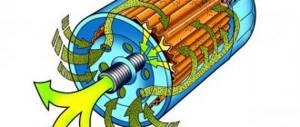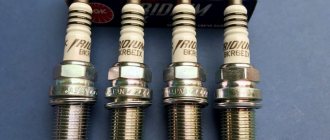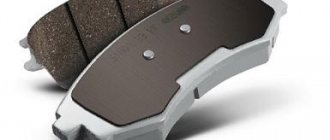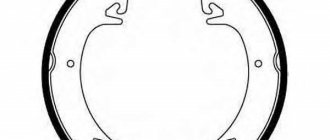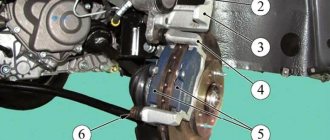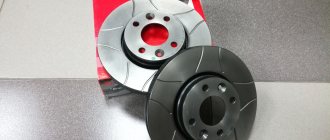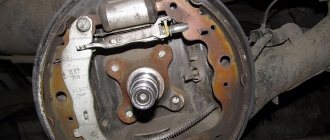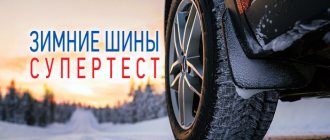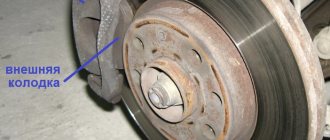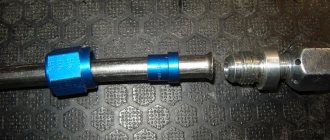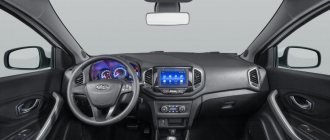The safety of the driver and passengers depends on the serviceability and reliability of many vehicle systems and, first of all, on the brake system. One of the factors that determines the efficiency of its operation is the quality of the brake pads.
- 2 Selecting pads based on performance characteristics
- 3 How to test drive pads
- 4 Test results for pads from various manufacturers
- 5 Results of laboratory testing
Important aspects of selecting brake pads
The quality of brake pads is determined primarily by which manufacturer produces them. Therefore, before purchasing them (regardless of which cars - domestic or foreign cars), you need to pay attention to the following general aspects of choice.
The originality of the product is the first of them. This is a very important point. It's no secret that the auto parts market is literally filled with many fakes. In addition, there is a certain difference between products of the same manufacturer: the market offers original spare parts produced for the assembly line on which cars are assembled, and at the same time there are original spare parts produced directly for sale in the wholesale and retail chains.
It makes no sense to consider pads intended for the conveyor, since they are quite expensive and quite rare on the market - their quantity in the total volume of this product, as a rule, does not exceed 10%. Original products for sale can be found much more often, and their cost is 30–70% of the price of conveyor ones. There are also pads that are significantly inferior in quality to the original ones, but are produced at the same factory along with them. These products are aimed at a wide range of different consumers, including those from developing countries. The price of these pads is 20–30% of the cost of the original.
How do you know if brake discs need replacing?
Before you start replacing discs, you need to find out what kind of wear is allowed on brake discs, after which you can search for the necessary spare parts and replace them. The need to replace brake discs can be determined by taking appropriate measurements of the residual wear of the working surface using a special tool. However, most motorists determine the condition of brake discs by indirect signs, including the absence of scale and deformation, the appearance of noticeable vibration on the brake pedal, and a significant decrease in the efficiency of slowing down the car. If your car shows such signs of worn-out brake discs, then in such a case it is necessary to contact a service center as soon as possible and replace them.
Selecting pads based on performance characteristics
The next general aspect of choosing pads is their performance characteristics. For the practical use of these spare parts on a car, this point is the most important. At the same time, this is a very individual aspect, since drivers are still different and, accordingly, their driving style is different. Therefore, in this case, it no longer matters who drives what car, the main thing is how he does it. This is why pad manufacturers, as a rule, at presentations of their new product or in its descriptions give appropriate recommendations regarding the selection of one or another model. There are pads that are recommended for:
- drivers whose main driving style is sports;
- frequent vehicle use in mountainous areas;
- moderate operation of the machine in city conditions.
Before making such recommendations, manufacturers conduct testing, on the basis of which a conclusion is made about the performance characteristics of the pads.
To figure out exactly what product is being offered for sale, you need to pay close attention to its packaging. In resolving this issue, you should rely on your own keen eye or select a spare part together with a specialist (master) involved in the maintenance of the car to which you need to install brake pads. When choosing them, you need to pay attention to the country and year of manufacture, badges confirming product certification, packaging design, inscriptions on it (evenness of lines, correct spelling, clear and legible printing), as well as the integrity of the brake pad itself (no cracks, bulges) , chips, tight fit of the friction material lining to the metal base).
How to test drive pads
To conduct a comparative test, each set of run-in brake pads is subjected to 4 tests on special stands. First, they simulate the braking of a car accelerated to 100 km/h. This test is basic. It helps to determine the coefficient of friction of the disc-pad pair for cold brakes (up to 50 ° C). The higher the coefficient obtained, the correspondingly higher the friction parameters of the pad.
But brakes, when used intensively, can sometimes heat up to 300 °C or more. This is especially true for very active drivers who brake frequently and intensively from high speeds. To check whether the pads can withstand this operating mode, after the “cold” test, a “hot” test is performed. The disc and pads are heated by continuous braking to a temperature of 250 ° C (the degree of heating is controlled using a thermocouple, which is implanted directly into the friction material of one of the pads). Then control braking is done at the same speed of 100 km/h.
The third test is even tougher. During it, multiple cyclic braking is simulated while driving on a mountain road. This test includes 50 decelerations from 100 km/h to a speed of 50 km/h with breaks of 45 seconds to spin up the flywheel of the test stand. The result of the 50th (last) braking is of the greatest interest - despite some cooling of the pads during the spin-up of the flywheel, by the 50th braking cycle the material temperature of many of them is 300 °C.
The last test is also called the recovery test - it checks how “warmed up” brake pads are able to maintain performance after cooling. To find out, after the “mountain” test, the brakes are cooled down to the temperature of the surrounding (test) environment, and naturally (not forcibly). Then control braking is performed again after accelerating to 100 km/h.
Based on the results of the tests, 4 friction coefficient values are obtained for each individual set of pads - one for each test. In addition, at the end of each individual test cycle, the thickness of the friction material lining is measured, thereby collecting information about wear.
Test results for pads from various manufacturers
There are quite a lot of manufacturers of car pads, and the cost range for different products is quite large, so it is quite difficult to determine which ones will be the best without trying them out or testing them. Below are the results of tests carried out by the testing workshop of the domestic car manufacturer AvtoVAZ with the participation of the Center for Independent Expertise and the Autoreview magazine. It should be noted that for pads installed on VAZ cars, technical conditions TU 38.114297-87 are applied, according to which the lower limit of the friction coefficient at the “cold” testing stage is 0.33, and during “hot” testing – 0.3. At the end of the tests, the pad wear was calculated as a percentage.
The samples used for testing were pads from different manufacturers (including Russian) and different price groups. Some of them were tested not only with the original disk, but also with the VAZ one. Products from the following manufacturers were tested:
- Ukraine: DAfmi, Trans Master;
- Germany: ATE, Bosch;
- UK: Ferodo, AP Lockheed, Lucas, QH;
- Denmark: Roulunds;
- Italy: Samko;
- Hungary: Rona;
- Russia: VATI, EZATI, Polyhedron, TIIR, STS;
- unknown: Best.
The samples were purchased at a retail outlet and information about their manufacturers was taken exclusively from the packaging.
The brake pad test revealed the following. The best results in the cold test were given by QH, Samko, ATE, Roulunds and Lucas. Their results were respectively: 0.63; 0.60; 0.58; 0.55 and 0.53. Moreover, for ATE and QH, the highest friction coefficient was achieved not with original wheels, but with VAZ wheels.
The results of the hot braking test were quite surprising. During this test, Roulunds (0.44) and ATE (0.47) performed well. The Hungarian Rona, as in the previous test, gave a coefficient of 0.45.
According to the results of the “mountain cycle”, the Rona pads turned out to be the best (0.44), which continued to maintain a position of stability, and also, which is important, heated up to a relatively low temperature of only 230 ° C. The QH company's products had a friction coefficient of 0.43, and this time with their own, original discs.
During the final “cooled down braking” test, the Italian Samko pads (0.60) again performed well, cooled down and rose above the Rona pads (0.52), with the QH products being the best (0.65).
Final extreme test: 11,000 km on the cheapest and most expensive brake pads
And now our comparative test of pads, which is far from perfect, has come to an end. And not on its own, but after a call from our volunteer test pilot Ilya:
- Hello! Let's change these pads, shall we? The stench is so bad it’s impossible to drive!
Well, if a person asks, let’s meet him halfway. We have to admit that the pilot’s peace of mind is more valuable to us than experiments, so we go to the service center and change the pads. At the same time, we look at the condition of our originals and inexpensive analogues. The conclusions, by the way, turned out to be ambiguous.
What's the point?
Now I remind you in more detail. Last November we did the following: we took a Skoda Yeti and bought two sets of brake pads . The first one is original. It cost 10,000 (of course, it included both front and rear pads).
Articles / Practice Should you save on braking: comparing expensive and cheap brake pads Today's auto parts market is good and bad at the same time. The good thing about it is that the choice of auto components is truly huge - you can find parts for every taste and budget. But that’s precisely why he’s bad... 21408 4 19 11.11.2016
With the second set, we tried to find the most affordable one, and its quality was the last thing we were interested in. And we bought something from the Lithuanian packaging company EGT. Since this company works with more than 70,000 manufacturers, it was not possible to find out the nature of the origin of the pads; they only have the inscription EGT. This set cost 3,500 rubles.
Since we have one car, but ambitions for a whole road train, we installed cheap pads on the right side of the Yeti, and original ones on the left. And we immediately stopped at the brake test bench. His data pleased us: the difference in maximum braking force was 13%, in the parking brake force - only 2%. Of course, it would be hard to expect anything different from a car with ABS and ESC. And yet, some relationship was clearly established: the right side brakes a little worse, but within normal limits, you can even pass a technical inspection. Pleased with the deed we had accomplished, we sent Ilya to ride and wear out our experimental pads.
After the first thousand kilometers, we met again at the service center and measured the braking forces . This time the results slightly surprised us: the difference in maximum braking force was 33%, and the specific braking force was different by 43%. The most interesting thing is that this happened after the pads were broken in. After measuring at the stand, we removed the pads and measured how much they “lost” during operation.
Of course, after 1,000 kilometers there was no serious wear either front or rear. We were generally pleased with the original front pads: no matter how we felt them with a caliper, we found no changes in thickness. And they began to fear for the brake disc: hard “eternal” pads can often wear it off quickly.
Since then the car has run another 10,000 km. I’ll say right away: it never reached the point of complete wear, and with the pads we installed we could still drive and drive. But Ilya was so annoyed by the smell in the car that we took pity and decided to end the experiment. So, we are back at the service center and removing the pads again. The wear on the rear ones was a little more noticeable (which is natural for a car with ESC), with the maximum being noticed on the EGT pads and amounting to 1.5 mm.
There was no sensation
Let's start from the left side, that is, with the “good” OEM pads. As soon as the wheels were removed, it became obvious that Ilya did not spare the car. Especially the brakes. The discs show obvious signs of overheating, and the front one shows signs of noticeable wear, which did not exist some 11 thousand kilometers ago. Well, how do the original front pads feel? The thickness of the outer is 18.9 mm, the inner is 18.5 mm. Let us remind you that the previous measurement showed exactly 20 mm, the thickness of the new ones is the same 20 mm. The wear of these pads turned out to be minimal (maximum - 1.5 mm), but for the disc it turned out to be the most significant.
1 / 2
2 / 2
The wear on the rear left disc is also noticeable, although not as much as on the front. We remove the pads and measure. The thickness of the inner pad is 13.5 mm, the outer pad is 14.8 mm. The previous measurement showed 17.0 and 17.5 mm, respectively, and the new ones were all the same - 18 mm. Thus, the maximum wear was 4.5 mm, and, looking ahead, I note: this is the maximum amount of wear from the entire set, including the analogue.
1 / 3
2 / 3
3 / 3
Now we perform the same operation on the right. The first thing that pleased me (and delighted the owner of the car) was that the right wheels remained in good condition. No uneven wear, grooves or other signs of impending replacement. We, of course, know that the disks will have to be replaced in pairs, but the left ones are really good. Well, we can be understood and forgiven for being right-wing. Maybe.
Front analog
So, the discs are smooth and even without signs of overheating. Remove the front pads and take a caliper. The remaining thickness of the inner pad is 17.9 mm, the outer one is 18.0. The wear is less than the original, the maximum is 2.1 mm. Let us remember that after a thousand kilometers the thickness was 19.2 and 19.5 mm, respectively. The difference with the original pads is also insignificant - from 0.5 to 0.6 mm.
But the result of measuring the rear pads was a little puzzling. Let me remind you that after the first thousand they set a record for wear rate - about 1.5 mm, and they were the only ones that did not wear out very evenly (the difference in measurements for one pad was 0.2 mm on both pads). But the latest data turned out to be as follows: outer block - 14.7 mm, inner block - 14.8 mm. The original size is 17.5 mm, which is less than the original pads. Thus, the wear was 2.7-2.8 mm - less than the OEM (up to 4.5 mm). But the disc is much better preserved, which overall looks a little strange.
1 / 2
2 / 2
It's not just size that matters
By and large, the wear rate of the pads is not the most important factor when choosing pads. Still, their main task is to effectively slow down the car.
I repeat once again: in a car stuffed with electronic systems, it is impossible to adequately assess pedal effort or braking efficiency using the method we used. But some data can still be obtained, so let’s try to analyze it.
Firstly, a difference in braking force of more than 30% is already alarming. Whatever one may say, cheap analogues do not slow down as effectively as the originals. Although if you don’t suffer from nonsense and install the same pads, then there is practically no difference, at least in the city.
Articles / Practice Original versus analogue: comparing cheap and expensive brake pads after grinding in. Quite recently, we started an experiment, the result of which should answer the age-old question: is it worth paying for original pads or can you install a cheap analogue, saving money and... 49244 4 12 11/30/2016
Secondly, in real operating conditions there is still a difference. But it only appears at high speeds. If you try to brake to the floor from a speed of 150 km/h, the car noticeably pulls to the left: this is not the highest efficiency of its analogues. The situation can easily be corrected with the steering wheel, but in real life no one will drive on different pads and most likely will not notice the difference.
The difference becomes slightly more noticeable when braking from a speed of under 200 km/h. But this is already from the category of exotic; in everyday use by a normal person there are neither such speeds nor the need to brake sharply on the highway.
Although in an extreme situation, just a few meters may not be enough.
And one last thing: the smell from the EGT pads is really unpleasant. Moreover, it is very noticeable, and it is present in full in the cabin. Maybe if you don't go crazy and don't burn CDs, then there won't be a smell? Hardly. Once you drive a few meters and slow down, the amber appears in all its splendor.
Just in case, we checked the caliper guides, but did not find any jammed ones, and the pads emit an odor at the first touch of the brake pedal. For some, this may be a significant reason to throw them away after a couple of braking sessions.
So does it make sense to overpay for the original?
Still, 3 thousand is not 10. And even taking into account faster wear (which, however, was not noticed in our case), installing analogues is much cheaper. I would conclude this: if you prefer to drive aggressively and spend a lot of time on the track, then cheap pads are clearly not for you.
But analogues do not have to be the cheapest . The choice is now great; you can pick up quite decent pads in the mid-price range, which not only are not inferior to the originals, but may even surpass them. And they will still be significantly cheaper than OEM.
Therefore, I don’t think that “Kroilovo always leads to Podalalov.” Sometimes it makes sense to sit on thematic forums, read reviews and look for your ideal option. And who knows, maybe everything will work out well.
For assistance in preparing the material, we would like to express our gratitude to the service station “AUTO-DOK” (Leningrad region, Vsevolozhsk district, Novoye Devyatkino, no. 118)
Survey
What pads do you prefer?
Your voice
Total votes:
